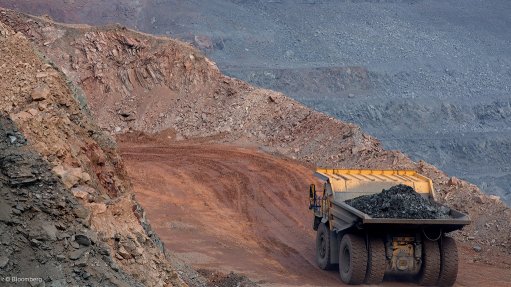
PRODUCTION IMMINENT
The Mofe Creek iron-ore project is located in one of Liberia’s historical premier iron-ore mining districts
Photo by: Bloomberg
ASX- and JSE-listed iron-ore-focused company Tawana Resources is planning a 2.5 million-tonne-a-year iron-ore mine in Liberia. Executive chairperson Wayne Richards believes the Mofe Creek iron-ore project, which is expected to start commercial production by the end of next calendar year, will be “the most exciting iron-ore venture on the continent”.
He says the mine will produce a high-quality product of more than 65% iron that “cannot be displaced anywhere, anytime, regardless of the iron-ore sales price and/or prevailing market dynamics”. He adds that the project will be a “high- margin, low operational expense producer, with huge expansive potential of up to ten-million tons a year”.
The Mofe Creek mine is located close to existing bitumen roads, which ensures that the transport of the mined iron-ore to market will be executed at minimal cost. “This is one of the key elements that underpins the low operational cost and minimal capital expenditure requirement for the project,” Richards says.
The project is located in one of Liberia’s historical premier iron-ore mining districts. It is 15 km from the Bomi Hills iron-ore mine, owned by international Indian iron-ore and steel producing company Vedanta; 80 km from the currently operational Bong iron-ore mine, owned and operated by China African Development Bank and Wuhan Iron & Steel Group; 65 km from the Mano River iron-ore mine; and 40 km from Bea Mountain Mine, currently owned by Vedanta.
“The project is characterised by exceptionally coarse-grained, friable, high-grade itabirite, which has the [potential] to produce a high-grade +65% iron product at a coarse-crush sizing, with high-mass recoveries and potentially low mine-stripping ratios and free-dig material,” he explains.
Other benefits of the Mofe Creek project are its low operating costs, which are the result of the simple beneficiation circuit design; high mineral recoveries; immediate proximity to working infrastructure, such as the Monrovia port; and low capital expenditure, with $52.9-million required to get the mine up and running. Richards adds that only four of a potential 18 mineralised zones have been drilled to date. The company also acquired a second adjoining tenement in August, which has an additional six mineralisation targets. Both tenements are 100%-owned by Tawana.
Richards says Tawana is proud of its progress over the past 12 months. “We announced a maiden resource estimate in March, completed a scoping study – the findings of which were contained in a release to the market in July– started a prefeasibility study and a mineral development agreement application in August, and submitted a baseline environmental- and social-impact assessment.”
Richards says the company plans to build a pilot plant on site, which will be used primarily for vocational training, and for storing technical data and marketing material, while creating local employment opportunities.
Through the development of the Mofe Creek project, Tawana is committed to becoming a midtier iron-ore producer. Richards believes that this goal will be achieved, owing to strong global demand for high-grade friable itabirite mineralisation with a final product grade greater than the traditional 62% iron.